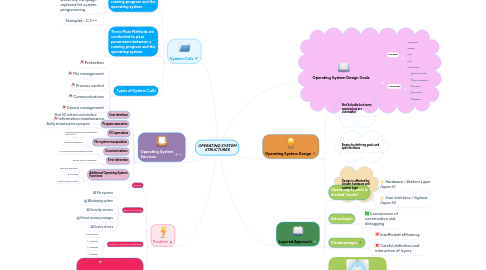
1. System Calls
1.1. Interface provider for a running program and the operating system
1.1.1. Assembly Language Instructions
1.1.2. Assembly Language replaced for system programming
1.1.3. Examples : C,C++
1.2. Three Main Methods are conducted to pass parameters between a running program and the operating system
1.2.1. Parameters are passed via registers
1.2.2. Parameters are either stored in a block,table or in memory
1.2.3. Address of block passed as a parameter in a register
1.2.4. Parameters are transferred in and out of the stack by the operating system
1.3. Types of System Calls
1.3.1. Protection
1.3.2. File management
1.3.3. Process control
1.3.4. Communications
1.3.5. Device management
1.3.6. Information maintenance
2. Operating System Services
2.1. User interface
2.1.1. Most OS contains user interface
2.2. Program execution
2.2.1. Ability to load and run a program
2.3. I/O operations
2.3.1. Operating system provides ways to perform I/O
2.4. File-system manipulation
2.4.1. Program capabilities
2.5. Communications
2.5.1. Processes may exchange information
2.6. Error detection
2.6.1. Ensure correct computing
2.7. Additional Operating System Functions
2.7.1. Resource allocation
2.7.2. Accounting
2.7.3. Protection and security
3. Microkernel
3.1. Definition
3.1.1. Only essential core operating system functions contained
3.1.2. Small operating system core
3.2. External Subsystems
3.2.1. File systems
3.2.2. Windowing system
3.2.3. Security services
3.2.4. Virtual memory manager
3.2.5. Device drivers
3.3. Benefits of a Microkernel Organization
3.3.1. Extensibility
3.3.2. Flexibility
3.3.3. Reliability
3.3.4. Portability
3.4. Microkernel vs Layered Kernel
4. Layered Approach
4.1. Operating System is divided (levels)
4.1.1. Hardware / Bottom Layer (layer 0)
4.1.2. User interface / highest (layer N)
4.2. Advantages
4.2.1. Convenience of construction and debugging
4.3. Disadvantages
4.3.1. Insufficient efficiency
4.3.2. Careful definition and interaction of layers
4.4. Layered Operating System
5. Operating System Design Goals
5.1. User goals
5.1.1. Convenient
5.1.2. Reliable
5.1.3. Safe
5.1.4. Fast
5.1.5. Easy to learn
5.2. System goals
5.2.1. Easy to design
5.2.2. Easy to maintain
5.2.3. Flexible
5.2.4. Error free
5.2.5. Reliable
